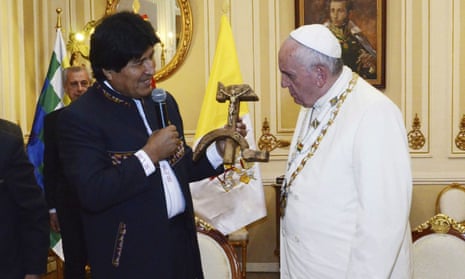Vatican officials appear to have been flummoxed after Pope Francis was presented with a communist crucifix depicting Jesus nailed to a hammer and sickle by Bolivia’s president Evo Morales.
The gift from the leftwing leader caused an immediate stir among conservative Catholics who said the pontiff was being manipulated for ideological reasons.
The response of the pope was less clear. After being handed the wooden crucifix during a formal ceremony, he examined it for a few seconds before returning it to a Bolivian presidential aide.
His comments were largely drowned out by a flurry of camera clicks, prompting a flood of speculation. While some have claimed he expressed irritation, muttering the words “eso no está bien” (“this is not right”), Vatican spokesman Federico Lombardi said the pope was more likely to have uttered “no sabía eso” (“I didn’t know that”) in bemusement at the origins of the present.
The Bolivian government insisted there was no political motive behind the gift. Communications minister Marianela Paco said Morales had thought the “pope of the poor” would appreciate the gesture.
“That was the intention of this gift, and it was not any sort of maneuver ... It was really from great affection” she told the Patria Nueva radio station.
But Rev James Bretzke, a theologian at Boston College in Massachusetts, accused Morales of attempting to manipulate the pope.
“Does this seem to be using the crucifix for political agenda? And I would say the answer is probably yes. Therefore, I would judge it personally in bad taste and especially manipulative to present it to the Holy Father in a situation like that where it clearly hadn’t been cleared ahead of time,” he told the Associated Press.
José Ignacio Munilla, bishop of the Spanish city of San Sebastián tweeted a picture of the encounter, with the words: “The height of pride is to manipulate God in the service of atheist ideologies.”
El culmen de la soberbia es manipular a Dios al servicio de ideologías ateas... Hoy, una vez más: #CristoCrucificado pic.twitter.com/uLbPPQDAGj
— Jose Ignacio Munilla (@ObispoMunilla) July 9, 2015
But it seems unlikely that the Pope would not have been completely unaware of the gift’s meaning. The crucifix was modelled on one owned by Luís Espinal, a Jesuit priest, journalist and leftwing activist who was murdered by paramilitaries in 1980, when Bolivia was under a dictatorship.
On Wednesday night, Francis halted his popemobile from the airport to pray at the site where Espinal’s body was found.
“Dear sisters and brothers. I stopped here to greet you and above all to remember. To remember a brother, our brother, a victim of interests who did not want him to fight for the freedom of Bolivia,” the pope said on the scheduled stop.
He also reportedly received a medal, bearing a hammer and sickle, from Morales that was issued in memory of Espinal’s death.
Lombardi said he personally wasn’t offended by Morales’ gift. “You can dispute the significance and use of the symbol now, but the origin is from Espinal and the sense of it was about an open dialogue, not about a specific ideology,” Lombardi said.
The Argentinian pope has been criticised in some quarters for not doing more to protect leftwing priests during the military dictatorship in his homeland. But since becoming pope in 2013, he has taken steps to reconcile the Vatican with progressive adherents of Liberation Theology, who argue that the Church should agitate for social and political change.
In Bolivia, Morales – a former coca farmer from an indigenous community – previously upset many in the local clergy by declaring the country secular in a new constitution. However, he has embraced the pope and praised him for supporting poor and marginalised groups.
Francis has used this trip to Latin America emphasize the problems faced by indigenous communities and to warn against “all totalitarian, ideological or sectarian schemes”.
On Thursday he urged the downtrodden to change the world economic order, denouncing a “new colonialism” by agencies that impose austerity programmes and calling for the poor to have the “sacred rights” of labor, lodging and land.
In one of the longest, most passionate and sweeping speeches of his pontificate, the Argentine-born pope also asked forgiveness for the sins committed by the Roman Catholic Church in its treatment of native Americans during what he called the “so-called conquest of America”.
Quoting a fourth century bishop, he called the unfettered pursuit of money “the dung of the devil,” and said poor countries should not be reduced to being providers of raw material and cheap labour for developed countries.
Repeating some of the themes of his landmark encyclical “Laudato Si” on the environment last month, Francis said time was running out to save the planet from perhaps irreversible harm to the ecosystem.
“Let us not be afraid to say it: we want change, real change, structural change,” the pope said, decrying a system that “has imposed the mentality of profit at any price, with no concern for social exclusion or the destruction of nature.“
“This system is by now intolerable: farm workers find it intolerable, laborers find it intolerable, communities find it intolerable, peoples find it intolerable The Earth itself – our sister, Mother Earth, as Saint Francis would say – also finds it intolerable,” he said in an hour-long speech that was interrupted by applause and cheering dozens of times.
- This article was amended on 10 July 2015 to correct an editing error which resulted in the mistranslation of the phase “I didn’t know that”.

Comments (…)
Sign in or create your Guardian account to join the discussion